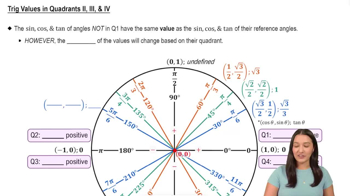Table of contents
- 0. Review of College Algebra4h 43m
- 1. Measuring Angles39m
- 2. Trigonometric Functions on Right Triangles2h 5m
- 3. Unit Circle1h 19m
- 4. Graphing Trigonometric Functions1h 19m
- 5. Inverse Trigonometric Functions and Basic Trigonometric Equations1h 41m
- 6. Trigonometric Identities and More Equations2h 34m
- 7. Non-Right Triangles1h 38m
- 8. Vectors2h 25m
- 9. Polar Equations2h 5m
- 10. Parametric Equations1h 6m
- 11. Graphing Complex Numbers1h 7m
3. Unit Circle
Reference Angles
Problem 57
Textbook Question
In Exercises 35–60, find the reference angle for each angle. _ 11𝜋 4
 Verified step by step guidance
Verified step by step guidance1
<Step 1: Understand the concept of a reference angle. A reference angle is the smallest angle that the terminal side of a given angle makes with the x-axis. It is always positive and less than or equal to 90 degrees (or \( \frac{\pi}{2} \) radians).>
<Step 2: Identify the given angle. The angle provided is \( \frac{11\pi}{4} \).>
<Step 3: Convert the angle to a standard position if necessary. Since \( \frac{11\pi}{4} \) is greater than \( 2\pi \), subtract \( 2\pi \) (or \( \frac{8\pi}{4} \)) from \( \frac{11\pi}{4} \) to find an equivalent angle within the first full rotation.>
<Step 4: Determine the quadrant in which the angle lies. After finding the equivalent angle, determine which quadrant it is in by comparing it to \( \pi \) and \( \frac{3\pi}{2} \).>
<Step 5: Calculate the reference angle. Depending on the quadrant, subtract the equivalent angle from \( \pi \) or \( 2\pi \) to find the reference angle.>
Recommended similar problem, with video answer:
 Verified Solution
Verified SolutionThis video solution was recommended by our tutors as helpful for the problem above
Video duration:
2mPlay a video:
Was this helpful?
Key Concepts
Here are the essential concepts you must grasp in order to answer the question correctly.
Reference Angle
The reference angle is the acute angle formed by the terminal side of a given angle and the x-axis. It is always measured as a positive angle and is typically between 0 and π/2 radians (0° and 90°). For angles greater than 2π or negative angles, the reference angle helps simplify trigonometric calculations by relating them to angles within the first quadrant.
Recommended video:

Reference Angles on the Unit Circle
Angle Measurement
Angles can be measured in degrees or radians, with radians being the standard unit in trigonometry. One full rotation (360°) is equivalent to 2π radians. Understanding how to convert between these two units is essential for finding reference angles, especially when dealing with angles expressed in radians, such as 11π/4.
Recommended video:

Reference Angles on the Unit Circle
Quadrants of the Unit Circle
The unit circle is divided into four quadrants, each corresponding to specific ranges of angle measures. The first quadrant contains angles from 0 to π/2, the second from π/2 to π, the third from π to 3π/2, and the fourth from 3π/2 to 2π. Knowing which quadrant an angle lies in helps determine its reference angle and the sign of its trigonometric functions.
Recommended video:

Introduction to the Unit Circle

 5:31m
5:31mWatch next
Master Reference Angles on the Unit Circle with a bite sized video explanation from Callie Rethman
Start learningRelated Videos
Related Practice






















